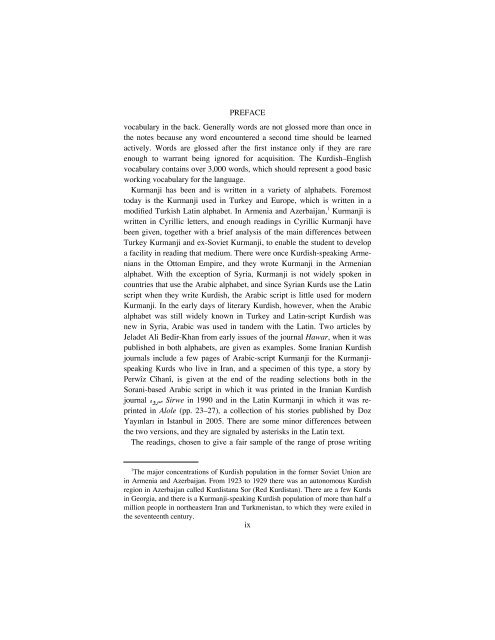Create successful ePaper yourself
Turn your PDF publications into a flip-book with our unique Google optimized e-Paper software.
PREFACE<br />
vocabulary in the back. Generally words are not glossed more than once in<br />
the notes because any word encountered a second time should be learned<br />
actively. Words are glossed after the first instance only if they are rare<br />
enough to warrant being ignored for acquisition. The Kurdish–English<br />
vocabulary contains over 3,000 words, which should represent a good basic<br />
working vocabulary for the language.<br />
Kurmanji has been and is written in a variety of alphabets. Foremost<br />
today is the Kurmanji used in Turkey and Europe, which is written in a<br />
modified Turkish Latin alphabet. In Armenia and Azerbaijan, 1 Kurmanji is<br />
written in Cyrillic letters, and enough readings in Cyrillic Kurmanji have<br />
been given, together with a brief analysis of the main differences between<br />
Turkey Kurmanji and ex-Soviet Kurmanji, to enable the student to develop<br />
a facility in reading that medium. There were once Kurdish-speaking Armenians<br />
in the Ottoman Empire, and they wrote Kurmanji in the Armenian<br />
alphabet. With the exception of Syria, Kurmanji is not widely spoken in<br />
countries that use the Arabic alphabet, and since Syrian Kurds use the Latin<br />
script when they write Kurdish, the Arabic script is little used for modern<br />
Kurmanji. In the early days of literary Kurdish, however, when the Arabic<br />
alphabet was still widely known in Turkey and Latin-script Kurdish was<br />
new in Syria, Arabic was used in tandem with the Latin. Two articles by<br />
Jeladet Ali Bedir-Khan from early issues of the journal Hawar, when it was<br />
published in both alphabets, are given as examples. Some Iranian Kurdish<br />
journals include a few pages of Arabic-script Kurmanji for the Kurmanjispeaking<br />
Kurds who live in Iran, and a specimen of this type, a story by<br />
Perwîz Cîhanî, is given at the end of the reading selections both in the<br />
Sorani-based Arabic script in which it was printed in the Iranian Kurdish<br />
journal ﻩوﴎ Sirwe in 1990 and in the Latin Kurmanji in which it was reprinted<br />
in Alole (pp. 23–27), a collection of his stories published by Doz<br />
Yayınları in Istanbul in 2005. There are some minor differences between<br />
the two versions, and they are signaled by asterisks in the Latin text.<br />
The readings, chosen to give a fair sample of the range of prose writing<br />
1<br />
The major concentrations of Kurdish population in the former Soviet Union are<br />
in Armenia and Azerbaijan. From 1923 to 1929 there was an autonomous Kurdish<br />
region in Azerbaijan called Kurdistana Sor (Red Kurdistan). There are a few Kurds<br />
in Georgia, and there is a Kurmanji-speaking Kurdish population of more than half a<br />
million people in northeastern Iran and Turkmenistan, to which they were exiled in<br />
the seventeenth century.<br />
ix


